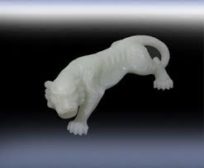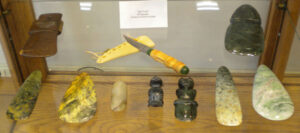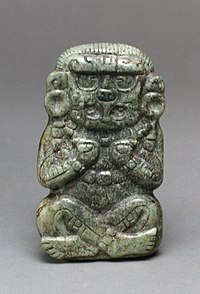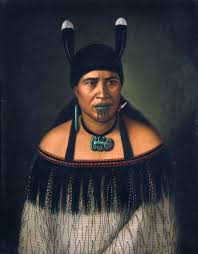I’m in the midst of writing my latest contemporary romantic suspense novel, The Jade Hunters. At the center of the story is the theft of a pair of white jade tiger earrings that originally belonged to the last emperor of China. As a result, I’ve been reading a lot about jade.

image from jademuseum.org

courtesy Jeff Spangler Northern California Jade
Some initial facts:
It’s one of two types of minerals, nephrite and jadeite, and comes in many colors, not just green. It’s also extremely durable and hard to break, which made it an obvious choice for weapons, tools, utensils and decorative objects. But what’s really interesting is that the early cultures that used jade ascribed super powers to it.
A Pain in the Side
Most modern readers associate the name “jade” with China, but in fact, the word comes from the Spanish phrase “Piedra de ijada,” which roughly translates to “stone for a pain in the side.” Spanish conquistadors learned that the Aztecs and Mayans revered jade for its curative capabilities—the locals would place the stone on the side of their body to heal, say, a stomach ache or a muscle sprain.

image from metmuseum.org

Image: aliexpress.com
The Chinese strongly relied on jade’s health-giving powers as well. For instance, they believed that wearing a jade bangle bracelet would absorb negative energy and that it reflected the wearer’s experience. If life was going great, the bangle would be bright and shiny, but if the person’s prospects dimmed, so too would the gem. Even today, green jade is said to have calming properties, able to balance the nerves, alleviate shock and allow its wearer to restore a normal heart rhythm in times of stress.
Care for a jade cocktail, anyone?
 How about this for a restorative libation: put equal parts powdered jade, rice and dew water into a copper pot, boil it, and drink the filtered “divine liquor of jade.” According to an antiquated Chinese encyclopedia, whoever drank the elixir would gain stronger, more supple muscles; harder bones; a calmer mind; “enriched” flesh; and purified blood. Keep drinking it and you would suffer from neither heat nor cold, nor feel hunger or thirst. Make mine a double!
How about this for a restorative libation: put equal parts powdered jade, rice and dew water into a copper pot, boil it, and drink the filtered “divine liquor of jade.” According to an antiquated Chinese encyclopedia, whoever drank the elixir would gain stronger, more supple muscles; harder bones; a calmer mind; “enriched” flesh; and purified blood. Keep drinking it and you would suffer from neither heat nor cold, nor feel hunger or thirst. Make mine a double!
Jade is worshipped in many cultures for its spiritual qualities, too. Chinese religious carvings date back to Neolithic times, and during the Han Dynasty (about two hundred years prior to the birth of Christ through 220 AD), rulers were buried with jade body plugs (I’m not enjoying that image in my head), because jade was said to be a great preservative. An ancient text proclaimed:

image from dhgate.com
“Jade cannot prevent the living from dying, but it can preserve the corpse from decaying.” To that end, some members of the upper class were even buried in complete body suits made out of thin jade plates. Using jade, the “stone of heaven,” was a means by which one could achieve immortality. This makes total sense to me: if I’m going to be around forever, I want to at least look good!
In the Maori culture of New Zealand, jade was considered so spiritually powerful that families created pendants called “hei tiki” that were passed on through the generations for protection.

courtesy wikipedia.org
If they needed a new pendant, they’d hire a wizard to search for the best spot in which to hunt for the raw jade. The wizard, called a “tohunga,” would go into a trance and ask the family’s ancestors where to look. Once they found a suitable specimen, a stone carver would figure out which spirit was residing in the jade. When the male head of the household passed away, the pendant would be buried with him, no doubt to guarantee safe passage to the afterlife. But later, the next male head of household would dig up the pendant and keep it so the family would continue to be protected.
A second century Chinese dictionary sums up the admiration and respect that many people, past and present, maintain toward jade:
Jade is the fairest of stones. It is endowed with five virtues. Charity is typified by its luster, bright yet warm; rectitude by its translucency, revealing the color and markings within; wisdom by the purity and penetrating quality of its note, when the stone is struck; courage, in that it may be broken but cannot be bent; equity, in that it has sharp angles which yet injure none.
A pivotal character in The Jade Hunters considers the jade earrings “a gift worth killing for.” Having delved into the lore surrounding these fascinating gemstones, I can see why he might say that.
Sources:
Exotic Gems Volume 4 by Renee Newman, GG (International Jewelry Publications)
“Jade in Ancient China” blog post by Mark Cartwright https://www.ancient.eu/article/1088/jade-in-ancient-china/
“Five Fun Facts about the History and Mythology of Jade” blog post by Corinne Dezoglio
https://blog.longsjewelers.com/estate/five-fun-facts-about-jade


